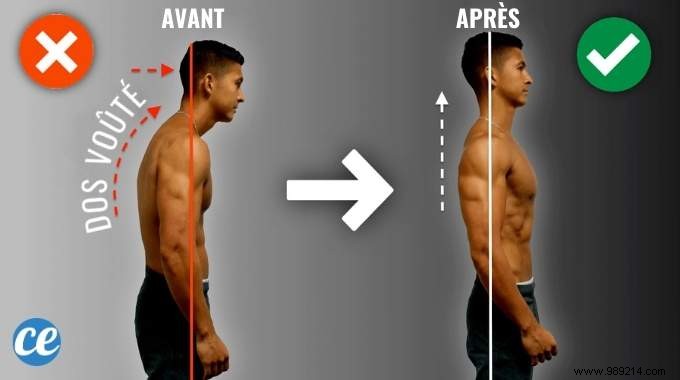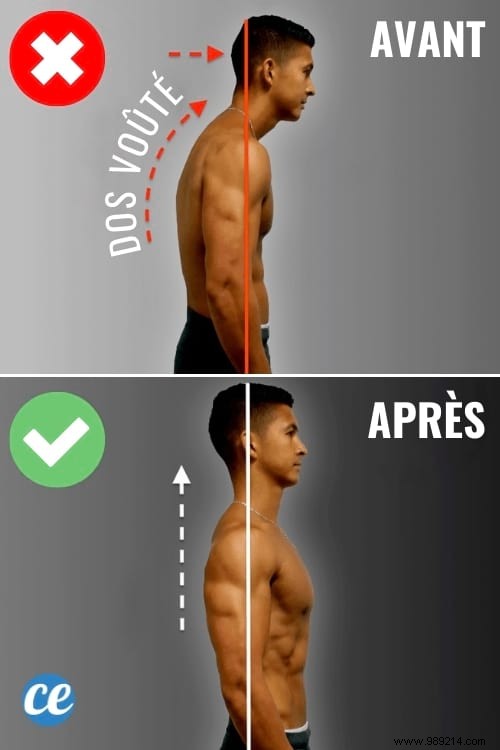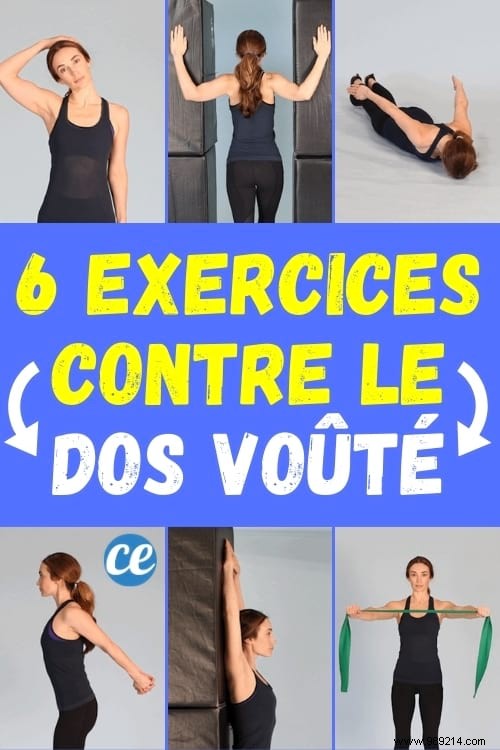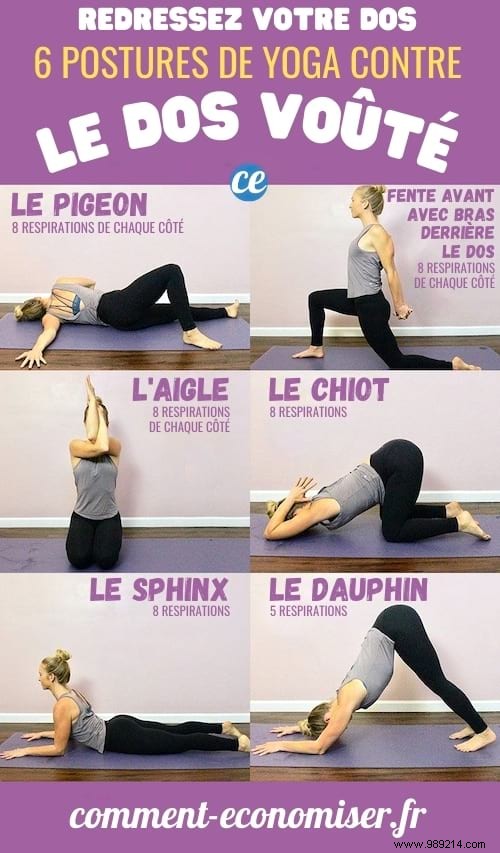
Do you have a hunched back?
The cause is often to keep your back bent in front of a computer screen...
But you can also have a hunched back from playing sports or driving.
Or even standing all day, bending down or staring at your smartphone...
As a result, we hold ourselves badly and we bend our backs.
The shoulders naturally tend to fall and the head leans forward.

Consequences ? The hunched back causes serious health problems :
- neck pain,
- headaches,
- lower back pain and
- poor blood circulation.
According to experts, poor posture can even lead to "upper cross syndrome."
This condition is characterized by the muscles of the chest, neck and shoulders being overstretched and deformed.
Fortunately, there are simple and effective remedies to improve this posture in women, men and adolescents.
To straighten your curved back, it is enough to perform exercises and stretches that strengthen the muscles.
So without further ado, here are 6 exercises to correct a hunched back . Watch:

This stretch targets the trapezius and scalene muscles. Located in the neck and shoulders, these muscles play an important role in posture and breathing.
1. When standing or sitting, keep your back straight and your shoulders down.
2. Move your ear down toward your shoulder, until you feel a stretch on the opposite side of your neck.
3. Hold this position for 15-30 seconds.
4. Do the same movement on the opposite side.
Do 2 sets of 15 to 30 seconds of stretching, on each side of the neck.
This stretch is great for correcting poor posture and a hunched back. It relaxes the chest muscles, while gently stretching the shoulders.
1. Stand in a standing position in front of a door frame, about 30 or 50 cm away.
2. Bend your elbows at right angles and raise your hands, so that your arms are parallel to the floor.
3. Place your forearms on either side of the door frame.
4. Put one foot forward on the other side of the door frame.
5. Slowly shift your weight onto the front foot, until you feel a stretch in your chest.
6. Hold this position for 15-30 seconds.
Do 3 sets of 15 to 30 seconds, two to three times a day.
This hand-behind-the-back stretch helps loosen the pecs and stretch the shoulders. This is also a great bicep stretch.
The movement requires some shoulder flexibility. So if you feel pain when stretching, just reduce the range of motion.
1. Stand in a standing position with your back straight, feet hip-width apart and arms along your body.
2. Cross your hands behind your back, with your thumbs facing the floor.
3. Keep your back straight, pull your shoulders back, and raise your hands toward the ceiling. Stop when you feel a stretch in your biceps and shoulders.
4. Hold this position for 20-30 seconds.
5. Slowly release the stretch and return your hands to the starting position.
Do 2 sets of 20 to 30 seconds of stretching, once or twice a day.
This exercise, also called "I-T-Y", helps strengthen the stabilizing muscles in the shoulders and upper back.
1. Get on your stomach, in a lying position and with your forehead touching the ground.
2. Put your arms in the "I" position:arms straight in front of you and thumbs up.
3. Raise your arms as high as possible. Pause and lower your arms slowly.
4. Put your arms down in a "Y" position. Raise them as high as possible and lower them slowly.
5. Put your arms out to the side in a "T" position. Raise them as high as possible and lower them slowly.
6. Return to position "I" and repeat.
Do 2 sets of 10 repetitions, once or twice a day.
The spread with an elastic band takes the tension off the chest. It also helps strengthen the muscles of the upper back and shoulders.
To do this exercise, you need a rubber band, also called a resistance band. Be aware that the bands have several levels of resistance, depending on your physical condition.
1. Get into a standing position. Keep your back straight, feet hip-width apart and legs slightly bent.
2. Tighten the band with your hands, from above. Extend your arms straight out in front of you.
3. Pull the band up, slowly spreading your hands out to the sides. Try to imagine that you are squeezing a small ball between your shoulder blades.
4. Return your arms to the starting position, slowly releasing the tension of the band.
Do 2 sets of 10 to 12 repetitions, once or twice a day.
This movement corrects the alignment of the shoulder blades and improves the flexibility of the shoulder muscles.
This exercise also trains you to hold your shoulder blades back.
1. Get into a standing position with your back against the wall and your arms along your body.
Throughout the exercise: press your head, upper back and buttocks against the wall. The feet are slightly apart from the wall.
2. Put your arms above your head and against the wall. The palms are facing forward and the knuckles are touching the wall.
3. Bend your arms at a right angle, while keeping your arms against the wall. This is the starting position.
4. Slowly slide your arms along the wall, as high as possible. At the same time, keep your back, shoulders, elbows and wrists against the wall.
5. At the end of the movement, pause.
6. Slowly lower your arms, sliding them along the wall, back to the starting position.
Do 2 sets of 10 repetitions, once or twice a day.
To correct the hunched back, first favor stretching and muscle building .
Apart from that, you can also consider manual soft tissue therapy, by a physical therapist.
This helps to relax muscle tension in the chest area, often associated with a hunched back.
Some people prefer to wear a support brace, also called a "corset" or "back straightener".
Worn at shoulder level, it helps maintain good neck and shoulder posture.
If this is an option that interests you, talk to your doctor or a physical therapist.
Both will help you choose the best orthosis according to your morphology.
You can perform any exercise as long as you don't feel any pain or discomfort.
It's as simple as that.
Again, what the experts advise is to stretch and strengthen your muscles regularly .
Most often, drooping shoulders are caused by an imbalance between the muscles of the chest, shoulders, and upper back.
To correct this poor posture, your stretches and strengthening exercises should simultaneously target the muscles of your chest and upper back.
When doing exercises, remember to keep your back straight and not lean forward.
Many have hunched backs, drooping shoulders, or a head that leans forward.
Fortunately, there are stretching and strengthening exercises specifically designed to straighten a hunched back.
By performing them, you can easily correct muscle imbalances that lead to poor posture.
If you feel any pain or discomfort while doing these exercises, stop right away.
Consult a physical therapist or sports trainer, who can show you the correct movements for each exercise.
Want more exercises to fix that bad posture?
Here are 2 more infographics that will help you fix it:

Position nº1:the pigeon
Hold the pose for 8 breaths on each side.
Position nº2:forward lunge with arms behind your back
Hold the pose for 8 breaths on each side.
Position nº3:the eagle
Hold the pose for 8 breaths on each side.
Position nº4:the puppy
Hold the pose for 8 breaths.
Position nº5:the sphinx
Hold the pose for 8 breaths.
Position nº6:the dolphin
Hold the pose for 5 breaths.

Exercise #1: pectoral stretch with door frame
Exercise 2: raising arms on a wall
Exercise 3: the cobra posture
Exercise #4: traction with elastic band
Exercise nº5: back massage with massage roller
Have you tried these easy arched back exercises? Let us know in the comments if it worked for you. We can't wait to read you!